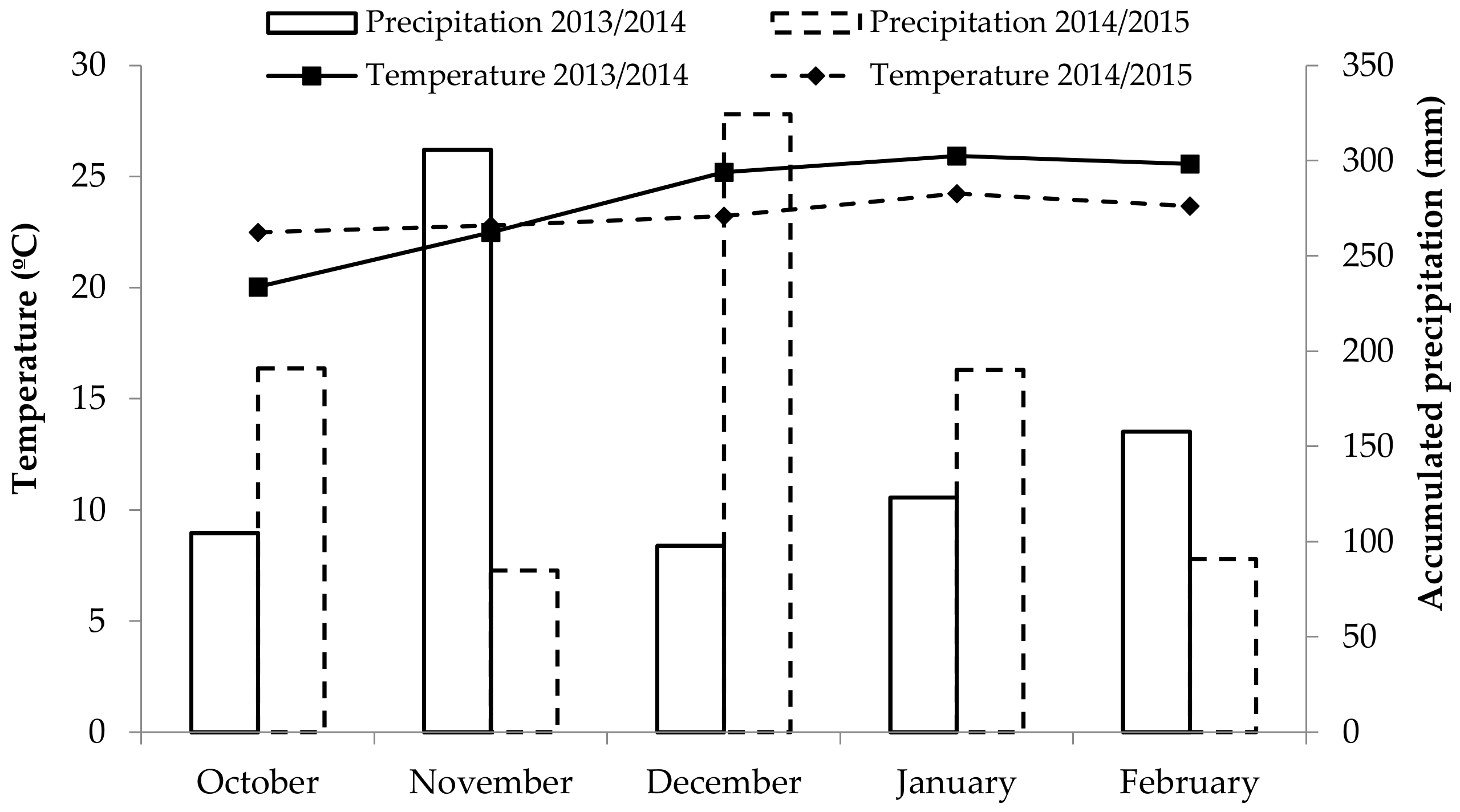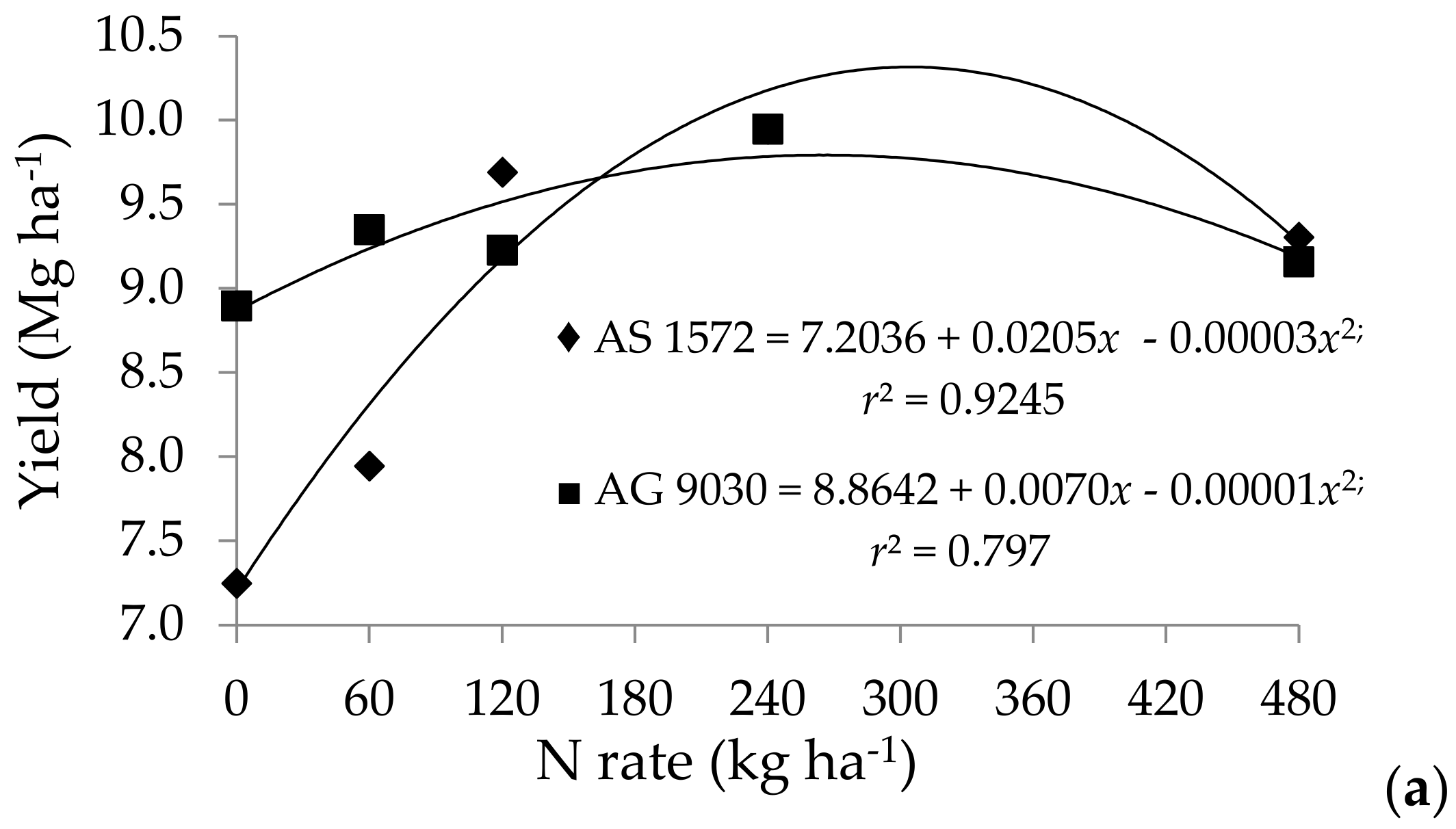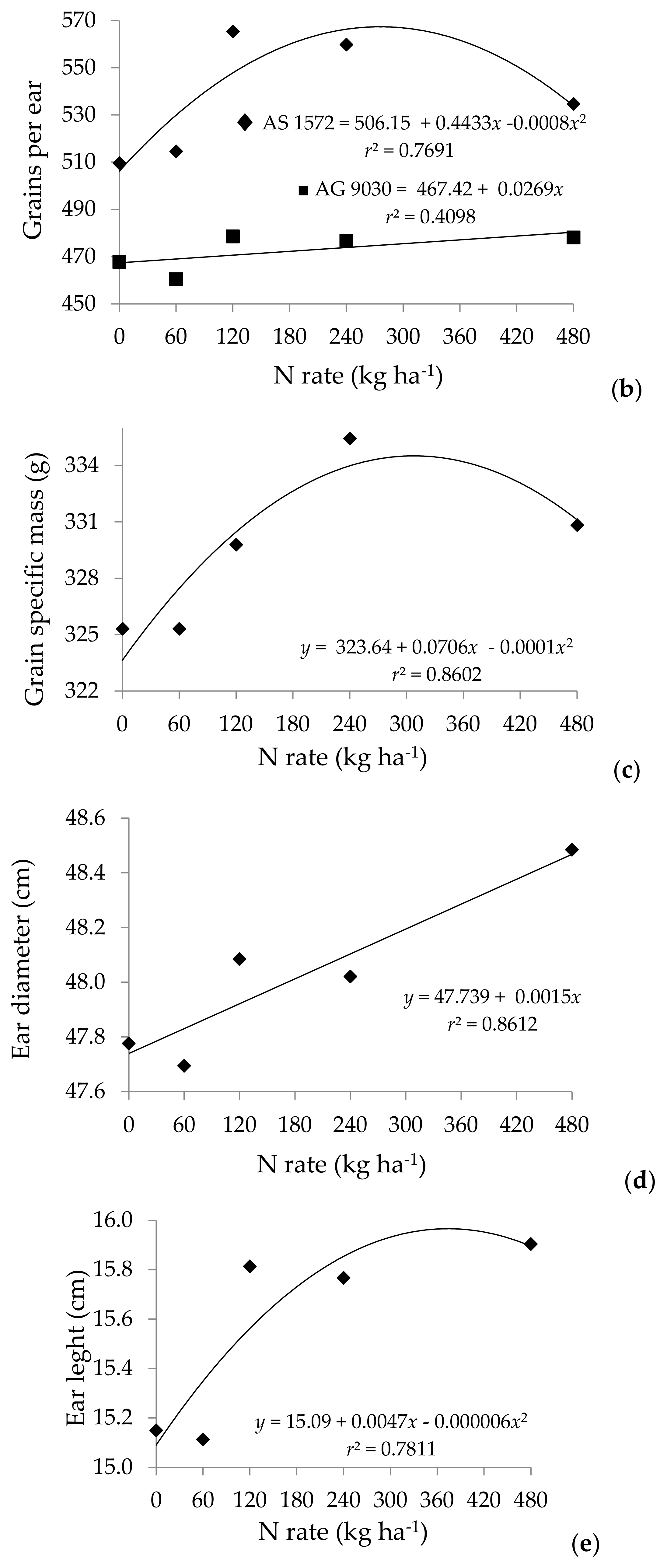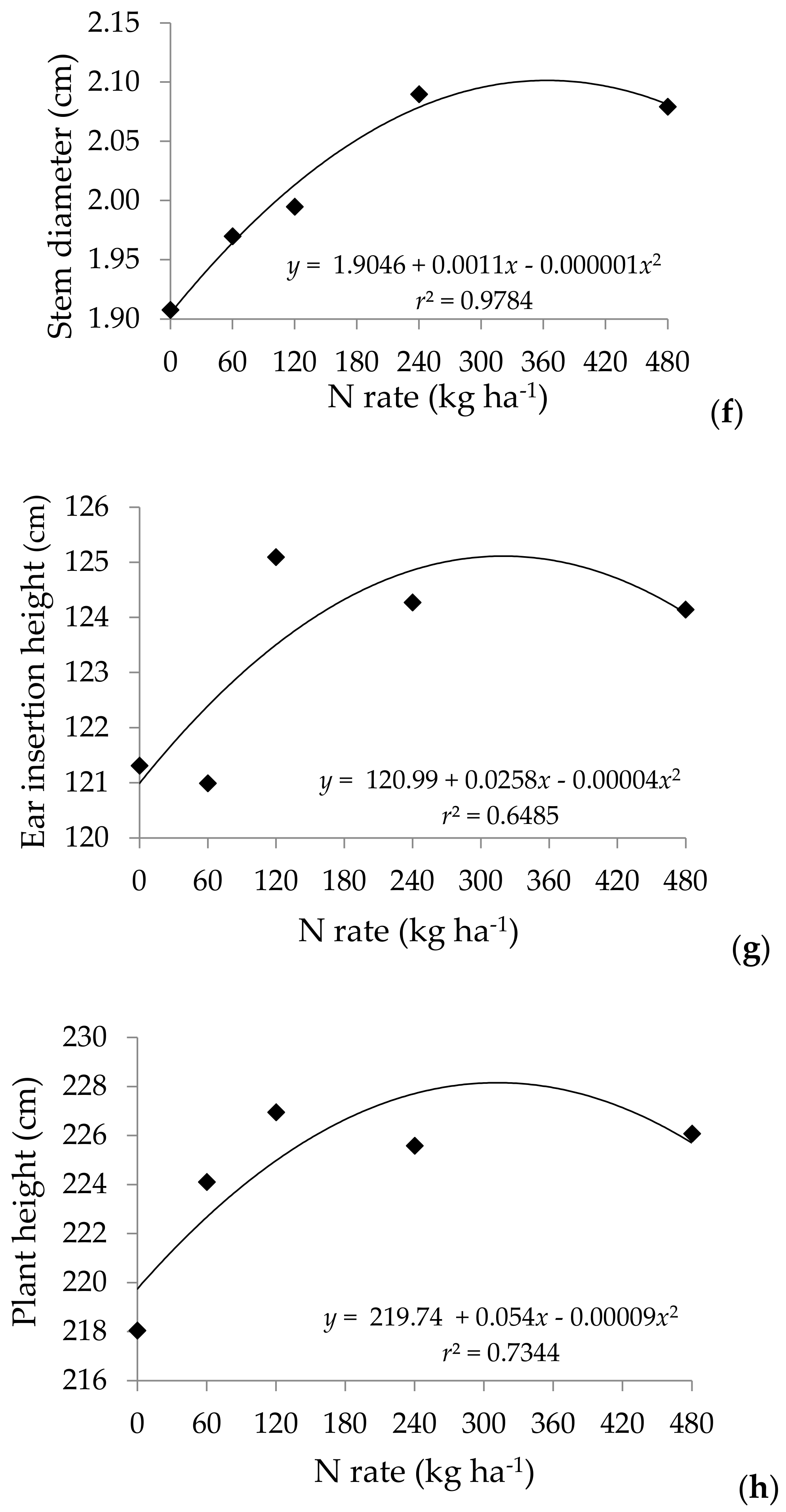Effect of Nitrogen Topdressing Fertilization and Inoculation of Seeds with Azospirillum brasilense on Corn Yield and Agronomic Characteristics
Abstract
:1. Introduction
2. Materials and Methods
3. Results
4. Discussion
5. Conclusions
Author Contributions
Funding
Conflicts of Interest
References
- Teixeira, F.F.; Andrade, R.V.; Oliveira, A.C.; Ferreira, A.d.S.; Santos, M.X. Diversidade no germoplasma de milho coletado na região Nordeste do Brasil. Rev. Bras. Milho Sorgo 2002, 1, 59–67. [Google Scholar] [CrossRef]
- Companhia Nacional de Abastecimento (CONABI). Acompanhamento da Safra Brasileira: Grãos. In Safra 2017/2018. Décimo Segundo Levantamento, Setembro de 2018; Conab: Brasília, Brazil, 2018; p. 148. [Google Scholar]
- Alcantara, R.M.C.M.; Sousa, S.R.; Xavier, G.R.; Rocha, M.M.; Rumjanek, N.G. Mecanismos Bioquímicos, Fisiológicos e Moleculares Relacionados Com a Eficiência de uso de Nitrogênio em Leguminosas e Gramíneas; Embrapa Meio Norte: Brasilia, Brazil, 2009; p. 39. [Google Scholar]
- Duete, R.R.C.; Muraoka, T.; Silva da, E.C.; Trivelin, P.C.O.; Ambrosano, E.J. Manejo da adubação nitrogenada e utilização do nitrogênio (15N) pelo milho em Latossolo Vermelho. Rev. Bras. Ciênc. Solo 2008, 32, 161–171. [Google Scholar] [CrossRef]
- Da Ros, C.O.; Aita, C.; Giacomini, S.J. Volatilização de amônia com aplicação de uréia na superfície do solo, no sistema plantio direto. Cienc. Rural 2005, 35, 799–805. [Google Scholar] [CrossRef]
- Lorensini, F.; Cereta, C.A.; Girotto, E.; Cerini, J.B.; Lourenzi, C.R.; Conti, L.; Trindade, M.M.; Melo, G.W.; Brunetto, G. Lixiviação e volatilização de nitrogênio em um Argissolo cultivado com videira submetida à adubação nitrogenada. Cienc. Rural 2012, 42, 1173–1179. [Google Scholar] [CrossRef]
- Bulow, J.F.W.; Von Döbereiner, J. Potential for nitrogen fixation in maize genotypes in Brazil. Proc. Natl. Acad. Sci. USA 1975, 72, 2389–2393. [Google Scholar] [CrossRef] [PubMed]
- Cassán, F.; Perrig, D.; Sgroy, V.; Masciarelli, O.; Penna, C.; Luna, V. Azospirillumbrasilense Az39 and Bradyrhizobiumjaponicum E109, inoculated singly or in combination, promote seed germination and early seedling growth in corn (Zea mays L.) and soybean (Glycine max L.). Eur. J. Soil Biol. 2009, 45, 28–35. [Google Scholar] [CrossRef]
- Montañez, A.; Abreu, C.; Gill, P.R.; Hardarson, G.; Sicardi, M. Biological nitrogen fixation in maize (Zea mays L.) by 15N isotope dilution and identification of associated culturable diazotrophs. Biol. Fertil. Soils 2009, 45, 253–263. [Google Scholar] [CrossRef]
- Bashan, Y.; Bashan, L.E. How the plant growth-promoting bacterium Azospirillum promotes plant growth a critical assessment. Adv. Agron. 2010, 108, 77–136. [Google Scholar] [CrossRef]
- Hungria, M.; Campo, R.J.; Souza, E.M.; Pedrosa, F.O. Inoculation with selected strains of Azospirillum brasilense and A. Lipoferum improves yields of maize and wheat in Brazil. Plant Soil 2010, 331, 413–425. [Google Scholar] [CrossRef]
- Moutia, J.F.Y.; Saumtally, S.; Spaepen, S.; Vanderleydejn, J. Plant growth promotion by Azospirillumsp in sugarcane is influenced by genotype and drought stress. Plant Soil 2010, 337, 233–242. [Google Scholar] [CrossRef]
- Videira, S.S.; Oliveira, D.M.; Moraes, R.F.; Borges, W.L.; Baldani, V.L.D.; Baldani, J.I. Genetic diversity and plant growth promoting traits of diazotrophic bacteria isolated from two Pennisetum purpureum Schum. Genotypes grown in the field. Plant Soil 2012, 356, 51–66. [Google Scholar] [CrossRef]
- Steenhoudt, O.; Vanderleyden, J. Azospirillum, a free-living nitrogen-fixing bacterium closely associated with grasses: Genetic, biochemical and ecological aspects. FEMS Microbiol. Rev. 2000, 24, 487–506. [Google Scholar] [CrossRef] [PubMed]
- Bashan, Y.; Holguin, G.; Bashan, L.E. Azospirillum plant relations physiological, molecular, agricultural, and environmental advances. Can. J. Microbiol. 2004, 50, 521–577. [Google Scholar] [CrossRef] [PubMed]
- Dobbelaere, S.; Croonenborgghs, A.; Thys, A.; Ptacek, D.; Okon, Y.; Vanderleyden, J. Effect of inoculation with wild type Azospirillum brasilense and A. Irakenses trains on development and nitrogen uptake of spring wheat and grain maize. Biol. Fert. Soils 2002, 36, 284–297. [Google Scholar] [CrossRef]
- Araújo, E.O.; Martins, M.R.; Vitorino, A.C.T.; Mercante, F.M.; Urquiaga, S.S. Effect of nitrogen fertilization associated with diazotrophic bacteria inoculation on nitrogen use efficiency and its biological fixation by corn determined using 15 N. Afr. J. Microbiol. Res. 2015, 9, 643–650. [Google Scholar] [CrossRef]
- Empresa Brasileira De Pesquisa Agropecuária—EMBRAPA; Centro Nacional de Pesquisas de Solos. Sistema Brasileiro de Classificação de Solos, 3rd ed.; Embrapa: Rio de Janeiro, Brazil, 2013; p. 353. [Google Scholar]
- Peel, M.C.; Finlayson, B.L.; Mcmahon, T.A. Updated world map of the Köppen-Geiger climate classification. Hydrol. Earth Syst. Sci. 2016, 11, 1633–1644. [Google Scholar] [CrossRef]
- Comissão De Fertilidade Do Solo RS/SC. Manual de Adubação e Calagem Para os Estados do Rio Grande do Sul e Santa Catarina, 10th ed.; Núcleo Regional Sul-Sociedade Brasileira de Ciência do SoloSegunda reimpressãoCapa: Porto Alegre, Brazil, 2004; p. 400. [Google Scholar]
- Moll, R.; Kamprath, E.; Jackson, W. Analysis and interpretation of factors which contribute to efficiency of nitrogen utilization. Agron. J. 1982, 74, 562–564. [Google Scholar] [CrossRef]
- SAS. SAS/STAT 9.3 User’s Guide; SAS Institute Inc.: Cary, NC, USA, 2011; p. 8621. [Google Scholar]
- Bergamaschi, H.; Matzenauer, R. Cultivos temporários: Milho. In Agrometeorologia dos Cultivos: O Fator Meteorológico na Produção Agrícola, 1st ed.; Monteiro, J.E.B.A., Ed.; Instituto Nacional de Meteorologia: Brasília, Brazil, 2009; 530p. [Google Scholar]
- Lana, M.C.; Dartora, J.; Mairini, D.; Hann, J.E. Inoculation with Azospirillum, associated with nitrogen fertilization in maize. Rev. Ceres 2012, 59, 399–405. [Google Scholar] [CrossRef]
- Morais, R.F.; Quesada, D.M.; Reis, V.M.; Urquiaga, S.; Alves, B.J.; Boddey, R.M. Contribution of biological nitrogen fixation to elephant grass (Pennisetum purpureum Schum.). Plant Soil 2012, 356, 23–34. [Google Scholar] [CrossRef]
- Dartora, J.G.; Guimarães, V.F.; Marini, D.; Sander, G. Adubação nitrogenada associada à inoculação com Azospirillum brasilense e Herbaspirillum seropedicae na cultura do milho. Rev. Bras. Eng. Agríc. Ambient. 2013, 17, 1023–1029. [Google Scholar] [CrossRef]
- Galindo, F.S.; Teixeira Filho, M.C.M.; Buzetti, S.; Santini, J.M.K.; Alves, C.J.; Nogueira, L.M.; Ludkiewicz, M.G.Z.; Andreotti, M.; Bellotte, J.L.M. Corn Yield and Foliar Diagnosis Affected by Nitrogen Fertilization and Inoculation with Azospirillum brasilense. Rev. Bras. Ciênc. Solo 2016, 40, 1–18. [Google Scholar] [CrossRef]
- Barassi, C.A.; Sueldo, R.J.; Creus, C.M.; Carrozzi, L.; Casanovas, E.M.; Pereyra, M.A. Potencialidad de Azospirillum en Optimizar el Crecimiento Vegetal Bajo Condiciones Adversas. In Azospirillum Sp.: Cell Physiology, Plant Interactions and Agronomic Research in Argentina; Cassán, F.D., Garcia De Salamone, I., Eds.; Asociación Argentina de Microbiologia: Buenos Aires, Argentina, 2008; pp. 49–59. [Google Scholar]
- Skonieski, F.R.; Viégas, J.; Martin, T.N.; Nörnberg, J.L.; Meinerz, G.R.; Tonin, T.J.; Bernhard, P.; Frata, M.T. Effect of seed inoculation with Azospirillum brasilense and nitrogen fertilization rates on maize plant yield and silage quality. Rev. Bras. Zootec. 2017, 46, 722–730. [Google Scholar] [CrossRef]
- Ferreira, J.S.; Moreira, L.Q.; Giori, F.G.; Reis, V.M. Avaliação de Duas Cultivares de Trigo Inoculadas Com Bactérias Diazotróficas em Condições de Casa de Vegetação; Boletim de Pesquisa e Desenvolvimento, Ed.; Embrapa Agrobiologia: Seropédica, Brazil, 2010; p. 20. [Google Scholar]
- Dobbelaere, S.; Croonenborgghs, A.; Thys, A.; Ptacek, D.; Vandereyden, J.; Dutto, P.; Labandera-Gonzalez, C.; Caballero-mellado, J.; Aguirre, J.F.; Kapulnik, Y.; et al. Responses of agronomically important crops to inoculation with Azospirillum. Aust. J. Plant. Physiol. 2001, 28, 871–879. [Google Scholar] [CrossRef]
- Badri, D.V.; Weir, T.L.; Van Der Lelie, D.; Vivanco, J.M. Rhizosphere chemical dialogues: Plant-microbe interactions. Curr. Opin. Biotechnol. 2009, 20, 642–650. [Google Scholar] [CrossRef] [PubMed]
- Blanco, R.B.; Sicardi, M.; Frioni, L. Plant genotype and nitrogen fertilization effects on abundance and diversity of diazotrophic bacteria associated with maize (Zea mays L.). Biol. Fertil. Soils 2015, 51, 391–402. [Google Scholar] [CrossRef]
- Merino, C.; Nannipieri, P.; Matus, F. Soil carbon controlled by plant, microorganism and mineralogy interactions. J. Soil Sci. Plant 2015, 15, 321–332. [Google Scholar] [CrossRef]
- Dimkpa, C.; Weinand, T.; Asch, F. Plant–rhizobacteria interactions alleviate abiotic stress conditions. Plant Cell Environ. 2009, 32, 1682–1694. [Google Scholar] [CrossRef]
- Ilyas, N.; Bano, A. Azospirillum strains isolated from roots and rhizosphere soil of wheat (Triticum aestivum L.) grown under different soil moisture conditions. Biol. Fertil. Soils 2010, 46, 393–406. [Google Scholar] [CrossRef]
- Reis, V.M.; Teixeira, K.R.S. Fixação Biológica de Nitrogênio–Estado da arte. In Processos Biológicos No Sistema Solo-Planta: Ferramentas Para Uma Agricultura Sustentável; Aquino, A.M., Assis, R.L., Eds.; Embrapa Informação Tecnológica: Brasília, Brazil, 2005; pp. 151–180. [Google Scholar]




| Yield | Grain Mass | Grain Per Ear | Grain Per Row | Prolif | Ear Length | Ear Diameter | Plant Height | NUE | |
|---|---|---|---|---|---|---|---|---|---|
| Inoculation | |||||||||
| A. brasilense | 8.95 | 329.25 | 505.00 | 16.57 | 0.948 | 15.61 | 48.11 | 223.71 | 71.60 |
| Control | 8.97 | 330.05 | 491.33 | 16.48 | 0.939 | 15.52 | 47.93 | 225.34 | 71.59 |
| Hybrids | |||||||||
| AS 1572 | 8.83 | 320.77 | 530.06 | 16.65 | 0.911 | 15.89 | 48.89 | 238.57 | 69.91 |
| AG 9030 | 9.10 | 338.54 | 466.28 | 16.41 | 0.976 | 15.24 | 47.15 | 210.47 | 73.29 |
| N rates (kg ha−1) | |||||||||
| 0 | 8.55 | 323.77 | 488.65 | 16.41 | 0.947 | 15.15 | 47.70 | 218.05 | 179.62 |
| 60 | 8.62 | 328.47 | 481.87 | 16.48 | 0.953 | 15.10 | 47.70 | 225.13 | 80.09 |
| 120 | 9.42 | 329.78 | 521.91 | 16.63 | 0.959 | 15.82 | 48.13 | 228.02 | 56.10 |
| 240 | 8.89 | 335.42 | 495.57 | 16.59 | 0.917 | 15.84 | 48.07 | 225.33 | 31.24 |
| 480 | 9.21 | 330.82 | 502.73 | 16.53 | 0.943 | 15.91 | 48.49 | 226.08 | 17.71 |
| Overall mean | 8.95 | 329.65 | 498.20 | 16.53 | 0.942 | 15.56 | 48.02 | 224.52 | 71.60 |
| Standard error | 0.14 | 0.95 | 2.26 | 0.72 | 0.07 | 0.18 | 0.37 | 13.29 | 13.49 |
| p-value | |||||||||
| I | 0.8853 | 0.6605 | 0.0344 | 0.4578 | 0.4063 | 0.5700 | 0.3728 | 0.2368 | 0.6569 |
| H | 0.1054 | 0.0001 | 0.0001 | 0.0603 | 0.0001 | 0.0001 | 0.0001 | 0.0001 | 0.0001 |
| N | 0.0021 | 0.0031 | 0.0015 | 0.7968 | 0.0886 | 0.0006 | 0.0539 | 0.0002 | 0.0091 |
| I × H | 0.0001 | 0.0206 | 0.0405 | 0.0382 | 0.2241 | 0.1608 | 0.0504 | 0.4455 | 0.5061 |
| I × N | 0.2622 | 0.7075 | 0.1628 | 0.2407 | 0.2722 | 0.1031 | 0.1741 | 0.1451 | 0.0031 |
| H × N | 0.0008 | 0.6817 | 0.0085 | 0.4256 | 0.1598 | 0.3477 | 0.0637 | 0.6377 | 0.0070 |
| I × H × N | 0.7343 | 0.8329 | 0.0020 | 0.9596 | 0.0386 | 0.0961 | 0.9199 | 0.3249 | 0.0587 |
| Variables | AS 1572 Hybrid | AG 9030 Hybrid | Standard Error | ||
|---|---|---|---|---|---|
| Azospirillum | Control | Azospirillum | Control | ||
| Yield | 8.928 a | 7.950 b | 8.982 | 9.088 | 0.15 |
| Grain per row | 32.99 a | 31.16 b | 28.69 | 28.48 | 0.39 |
| Grain per ear | 544.04 a | 515.76 b | 467.14 | 465.83 | 6.30 |
| Ear diameter | 49.17 a | 48.56 b | 47.24 | 47.07 | 0.12 |
| NUE | 73.62 a | 65.78 b | 69.51 b | 77.19 a | 13.49 |
© 2019 by the authors. Licensee MDPI, Basel, Switzerland. This article is an open access article distributed under the terms and conditions of the Creative Commons Attribution (CC BY) license (http://creativecommons.org/licenses/by/4.0/).
Share and Cite
Skonieski, F.R.; Viégas, J.; Martin, T.N.; Mingotti, C.C.A.; Naetzold, S.; Tonin, T.J.; Dotto, L.R.; Meinerz, G.R. Effect of Nitrogen Topdressing Fertilization and Inoculation of Seeds with Azospirillum brasilense on Corn Yield and Agronomic Characteristics. Agronomy 2019, 9, 812. https://doi.org/10.3390/agronomy9120812
Skonieski FR, Viégas J, Martin TN, Mingotti CCA, Naetzold S, Tonin TJ, Dotto LR, Meinerz GR. Effect of Nitrogen Topdressing Fertilization and Inoculation of Seeds with Azospirillum brasilense on Corn Yield and Agronomic Characteristics. Agronomy. 2019; 9(12):812. https://doi.org/10.3390/agronomy9120812
Chicago/Turabian StyleSkonieski, Fernando Reimann, Julio Viégas, Thomas Newton Martin, Cristian Carlos Amauri Mingotti, Stela Naetzold, Tiago João Tonin, Lisiani Rorato Dotto, and Gilmar Roberto Meinerz. 2019. "Effect of Nitrogen Topdressing Fertilization and Inoculation of Seeds with Azospirillum brasilense on Corn Yield and Agronomic Characteristics" Agronomy 9, no. 12: 812. https://doi.org/10.3390/agronomy9120812
APA StyleSkonieski, F. R., Viégas, J., Martin, T. N., Mingotti, C. C. A., Naetzold, S., Tonin, T. J., Dotto, L. R., & Meinerz, G. R. (2019). Effect of Nitrogen Topdressing Fertilization and Inoculation of Seeds with Azospirillum brasilense on Corn Yield and Agronomic Characteristics. Agronomy, 9(12), 812. https://doi.org/10.3390/agronomy9120812





